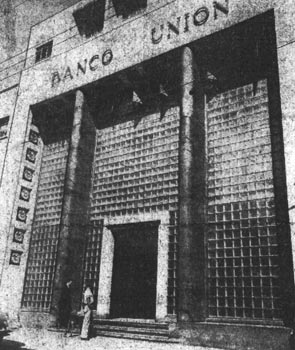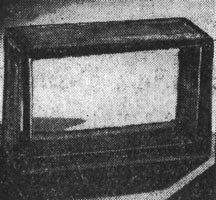[Newspaper]
Publication: The Toledo Blade
Toledo, OH, United States
Glass 'Brick' Advances
|
INSULUX GLASS BLOCK POPULAR IN LATIN AMERICA
Bank at Caracas, Venezuela, shows one adaptation
Owens-Illinois Glass Brick
Is 20 Years Old This Week
Insulux Distributors To Observe Date
At Meeting Which Opens in Toledo Today
Owens-Illinois Glass Co.'s Insulux glass block, which started out as an ordinary glass brick and since has turned into a scientifically engineered light directing unit, is 20 years old this week.
In observance of the anniversary is the first national Insulux distributor's meeting, which opened today in the Commodore Perry Hotel and continues through tomorrow. Distributors formerly met in regional sessions.
O-I's glass bricks were introduced to the public at the Chicago Century of Progress Exposition in 1933 where an all glass block building was constructed. Since then, 125,000,000 of them, enough to fill 25,000 freight cars, have been sold in this and 50 other countries. They have been exported as far away as Indonesia and have scored unusual popularity in Latin America.
Largest Installation
World's largest installation, 750,000 glass blocks, went into the temporary headquarters of United Nations, Lake Success, N. Y.
Top executives of O-I are scheduled to speak at the distributors' meeting. They include J. P. Levis, board chairman; C. R. Megowan, president; S. J. McGivern, O-I vice president and head of Kimble Glass Co., which now produces and markets Insulux glass block, and O. G. Burch, O-I director of research.
Marketed in 1935
E. B. Dennis, Jr., Kimble vice president and general sales manager, will explain diversity of Kimble's products, and E. P. Lockart, Insulux sales manager, will outline plans for 1953.
|
FIRST GLASS BRICK
And then came science . . . .
A number of the distributors have been in Insulux sales since 1935, when marketing was first started.
Tomorrow, the 200 visitors will tour Kimble's television tube plant on Westwood Ave.; the Libbey Glass division plant where table glassware is made, and the Daylighting Laboratory of the University of Michigan, Ann Arbor, where research in the scientific control of daylight through glass blocks is carried on.

